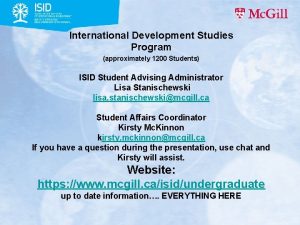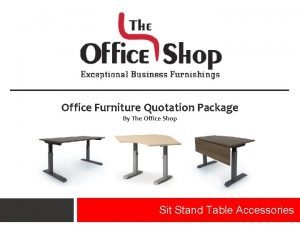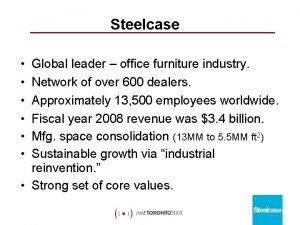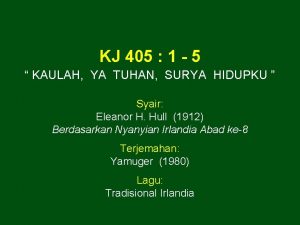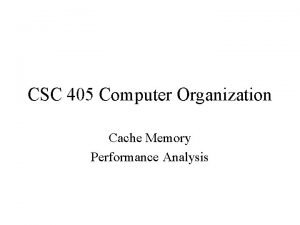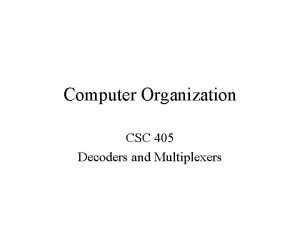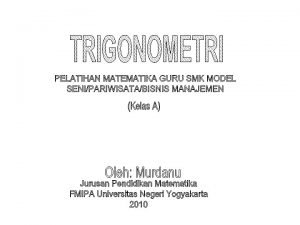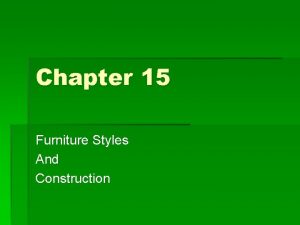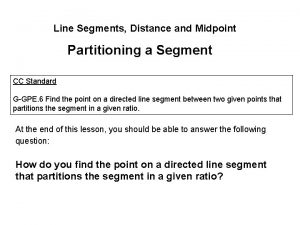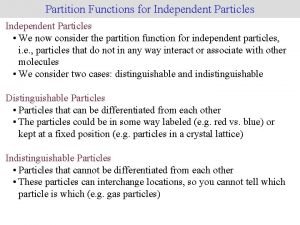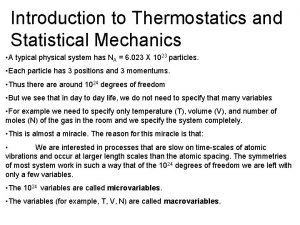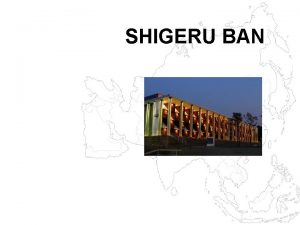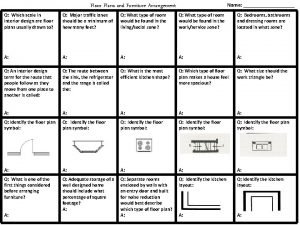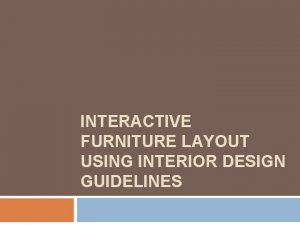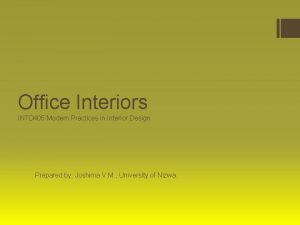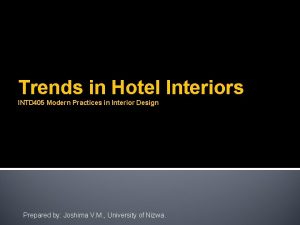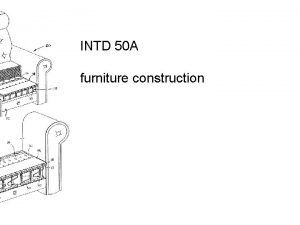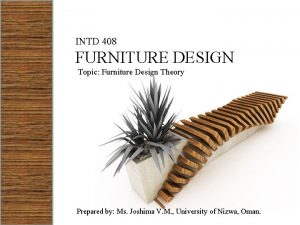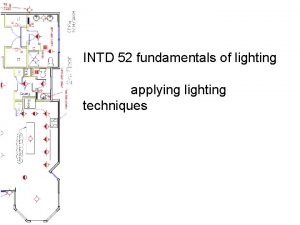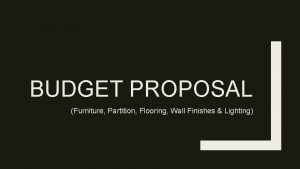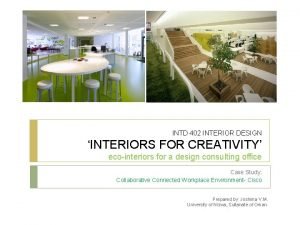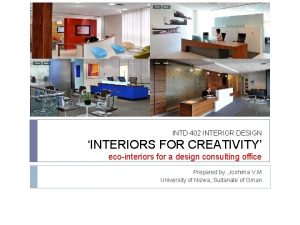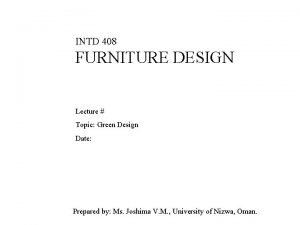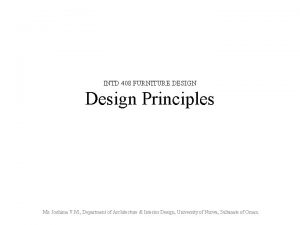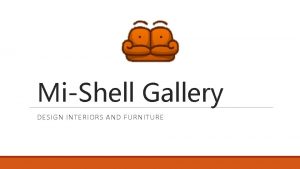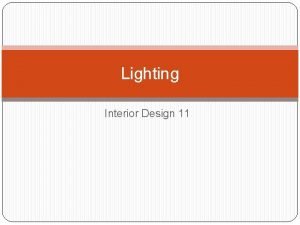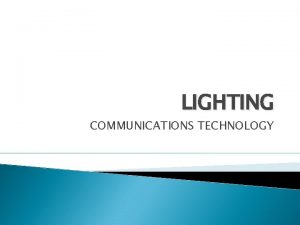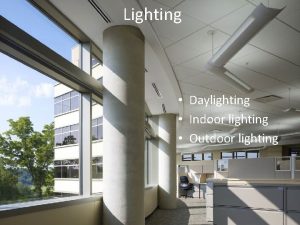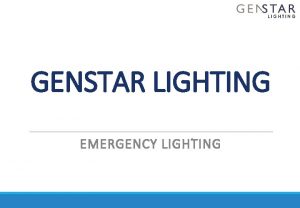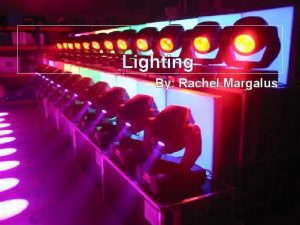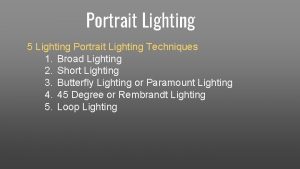Office Interiors Furniture Partition and Lighting INTD 405











































- Slides: 43

Office Interiors: Furniture, Partition and Lighting INTD 405 Modern Practices in Interior Design Prepared by: Joshima V. M. , University of Nizwa.

Office furniture The most common furniture items used by nearly all office staff are: Desk Chair Storage units Specialized items that are needed sometimes: Conference room table and chairs Cashier points Dealing desks Bulk-storage

Issues on which to base furniture choice Capital cost: initial price of the furniture. Cost in use: maintenance, reconfiguration cost etc. Desk edges: to know how the workstations come together or fit to the edges. Cable handling: capacity for cables, number and location of outlets. Standard of service: supply and installation. Dimensions Finishes and aesthetics: color appearance, surface finishes etc. Ergonomic, comfort, health and safety, green issues.

Extent of enclosure: low screens on the desks and tall screens surrounding the workstation.

Workstation The combination of a Desk, Chair and local storage of items are called Workstation. Two general philosophies of providing workstations are: Stand alone / free standing Integrated units Herman Miller produced the first commercially successful system furniture for offices in the 1960 s.

Furniture Mobility Addition of wheels are found in most of the furniture to create options for complete rearrangement of working areas with minimum effort. Wheels range from discrete carpet friendly casters to large pushchair wheels on the tables. Some uses folding units for tables, so that they can be neatly folded and stored when not in use. Some offices take care of the vertical mobility also. Eg: Digital Equipment Company office in Sweden, workers pull the PC down from above as and when required and set back at convenient height.

Desktop shapes Desk top shapes offer range of flexibility. Simple rectangular shape: Very cheap Can fit together in many ways Can be of different sizes Becomes less flexible if the drawers are fixed to the underside. L shaped: Extra surface, often a storage unit added to the table L shape can be on any side according to need.

Deep corner Suitable for deep VDTs (Virtual Data Toolkit). But far corner is wasted if very deep. Less flexibility in planning. Wave Informal shape Various seat positions Fairly simple and cheap Less flexibility in planning

With extensions Any shape addition May be wheeled or fixed. Gives wide range of possibilities Can cost more. Free form Different angles for different size groups. 3 -5 are common Rigid for planning.

Storage is the most important aspect of office furniture. There are rapid changes in what is being stored in the office and what is needed at the desk. Types of storage furniture: Two drawer filing Four drawer filing Cupboard four rows high Revolving Moving aisle Power filing


What to look for in storage furniture. Suitable dimensions that fit with other furniture and the building. Strong construction. Smooth finishes, especially where people come in contact with like the edges, corners etc. Doors and drawers that move easily. Good locks. Easily interchangeable inserts for cabinets that may perform many tasks. Robust casters with strong locking mechanism. Materials and colors that can be easily coordinated with rest of the furniture and building.

Storage walls

Office Partitions are provided in the offices for: Division of spaces physically and visually Sound reduction

Office partitions Office partitioning contains various materials, including: aluminum structural steel soft board whiteboard MDF gypsum board wall clear and opaque glass panel finishes such as wool, wool blends, vinyl, upholstery and other synthetic fabrics.







Acrylic room partitions



Portable office screens

Sound proof partition walls Sound Transmission Class is a common measurement of sound isolation. A higher STC figure means more sound isolation. UBC requirements for walls: STC rating of 50 (if tested in a laboratory) or 45 (if tested in the field). An STC of 50 is a common building standard and blocks approximately 50 d. B from transmitting through the partition. higher STC (STC 60) should be specified in sensitive areas where sound transmission is a concern.


Soundproof partition with carpet tiles.

Flooring The choice of flooring in an office refurbishment should involve consideration of appearance but also ease of maintenance. Entrances and receptions should have an area of barrier carpeting to ensure dirt does not travel into the general building areas. Mezzanine floors and Computer raised floor systems are common part of new offices.

Mezzanine Flooring Mezzanine is an intermediate floor between main floors of a building, and therefore typically not counted among the overall floors of a building. Area of mezzanine should not be more than 50% of the room area. The minimum ceiling height for a the mezzanine floor should be 2. 1 m.

Raised Floor or Access Floor A raised floor or access floors are types of floor that provide an elevated structural floor above a solid substrate. Created for the passage of mechanical and electrical services. They are widely used in modern office buildings, and in specialized areas where there is a requirement to route mechanical services and cables, wiring and electrical supply. Raised/Access Flooring can be installed at varying heights from 51 mm to heights above 1, 200 mm to suit services. Additional structural support and lighting are often provided when a floor is raised enough for a person to crawl or even walk beneath.

Use of raised floors Accommodate and conceal services Be flexible Sustain nd resist imposed loads Have good appearance and aesthetics. Sound control Thermal resistance Fire resisitance Durability Ease of maintenance

Components of raised floor 2 components of raised floors: Floor panel: nominal size of 600 x 600 mm. Depth from 25 mm to 40 mm. Made of particle board with galvanised steel finish of 0. 5 mm thick. Support pedestal: made of steel, concrete or timber. made in a range of heights to create cavity spaces from 30 mm to 1000 mm. Raised floor cavities should be regularly cleaned ( at least twice a year)to remove dust and debris.

Lighting Lighting is an essential provision for any workplace. It is preferable to provide uniform illumination over the entire workplace by combining both natural and artificial lighting. Good lighting helps us to see and to recognize hazards. It can reduce visual strain and discomfort. Poor lighting may affect workers' performance and health as poor visibility increases the chances of errors being made.

Types of lighting General lighting is designed for movement and casual work, such as filing. Localized lighting provides more intense illumination at the workstations. Local lighting units illuminate only specific work areas, like a desk.



Lighting guidelines Combine natural lighting with artificial lights to improve your workplace lighting. Light sources should be well located, illuminating the workplace as well as entrances and corridors. Disability glare usually happens when broad-band light illuminates your workstation, like light from a window. align your workstation at right angle to windows and similar light sources.

Discomfort glare does not cause direct visual interference, but it can be annoying or uncomfortable. It can be caused by direct or reflected light. This can be avoided by: reposition of the light source and, or the workstation appropriately, . avoid the use of well-polished surfaces reduce the contrast between your work area and its surrounding.

The light contrast between your task at the workstation and its immediate background should not exceed a ratio of 10: 3. (For example: the document and the desktop)

Backlighting will cast shadows of your head and, or body across your workstation. To avoid casting shadows, attention should be paid on the direction of the lighting. The minimum level of illumination recommended for work in general offices is 200 lux. The optimum lighting for normal desk work is between 300 and 500 lux. It should not be less than 200 lux under any condition.

If you are working with colours, like paint or ink, the type of lamp you use will be important. Generally lamps with high luminous efficiency render colours poorly but fluorescent lamps give both good colour rendering and good vision.

All electric lamps emit both light and heat. Tungsten filament lamps or halogen lamps with reflectors may focus the heat radiation causing possible discomfort or burns. Use ‘air-handling’ reflectors that disperse the heat, or Use uplighters to re-direct the light and heat radiation to the ceiling. Alternatively, use higher efficient lamps which demand a lower wattage, to reduce heat radiation.
 Intd minor mcgill
Intd minor mcgill Palladian interior design
Palladian interior design Aakaar interiors
Aakaar interiors Quotation for office furniture
Quotation for office furniture Unicor recycling
Unicor recycling Furniture industry leaders
Furniture industry leaders Bag mask ventilation
Bag mask ventilation Lan 405
Lan 405 Kj405
Kj405 David rockefeller memoirs page 405
David rockefeller memoirs page 405 Lan 405
Lan 405 405 000 in scientific notation
405 000 in scientific notation I went into the garden
I went into the garden Concilcard
Concilcard Upper and lower bounds significant figures
Upper and lower bounds significant figures Csc 405
Csc 405 Csc 405
Csc 405 Rumus segitiga trigonometri
Rumus segitiga trigonometri Micb 405
Micb 405 Norma portuguesa 405
Norma portuguesa 405 Prf in econometrics
Prf in econometrics Csc 405
Csc 405 Factory office plan
Factory office plan Smithe and shanahan furniture
Smithe and shanahan furniture Introduction of dramatization
Introduction of dramatization The scenery backdrops and furniture that create the setting
The scenery backdrops and furniture that create the setting Excessive use of ornamentation and massive proportions
Excessive use of ornamentation and massive proportions The trajectory
The trajectory Pursuit of sovereignty and impact of partition essays
Pursuit of sovereignty and impact of partition essays Partition these numbers
Partition these numbers Geometry partitioning a line segment
Geometry partitioning a line segment Rotational partition function
Rotational partition function Partition function
Partition function Lighting and color
Lighting and color Lighting and color
Lighting and color Lighting and color
Lighting and color Lighting and color
Lighting and color Mfi furniture
Mfi furniture Papertainer museum
Papertainer museum Auto bi furniture
Auto bi furniture Byrne custom woodworking
Byrne custom woodworking Floor plan arrangement
Floor plan arrangement Safi furniture
Safi furniture Furniture layout guidelines
Furniture layout guidelines
